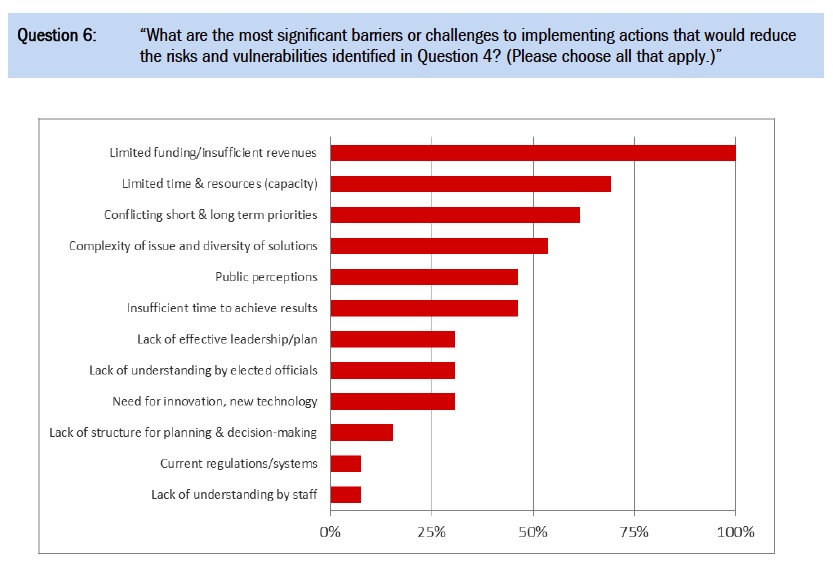POST CARBON INSTITUTE
Executive Summary
Over the last fifteen years, many US municipalities have set sustainability goals and implemented policies and programs to achieve them. More recently, resilience has emerged as an additional goal of some municipalities, particularly in the wake of extreme weather events like Hurricane Sandy and major economic disruptions like the Great Recession.
This study explored how some municipalities that are already leading the way on sustainability are now understanding and applying the concept of resilience. Senior staff at fourteen selected municipalities of various regions and sizes were surveyed on their communities’ perceived risks and vulnerabilities, and how these were being addressed. Five major conclusions were derived from the responses, some of which run counter to the “conventional wisdom” on resilience:
- While “resilience” is interpreted many ways, it is largely understood by these sustainability leaders to have a scope greater than mere disaster preparedness. This stands in contrast to the current public conversation on resilience in urban planning and policy circles (and increasingly in popular media and politics), where concerns about climate change and natural disasters generally dominate.
- Resilience-building is already regarded as an important part of these communities’ ability to deliver services, although respondents ascribed different specific activities to it. This was unexpected as resilience has not been a significant topic in local public policy and planning until only very recently.
- Lack of time and lack of resources are seen as the biggest barriers to resilience-building actions, not necessarily a lack of public or government awareness. Budgetary constraints also had a direct impact on the pace of adoption of relevant initiatives.
- Citizen pressure is a major influence on resilience-building actions. Citizens understand the need for greater resilience and want actions to enhance it.
- Neither national nor local regulations are seen as significantly hindering community resilience-building actions. Changes in local regulations are, in fact, pushing adoption of resilience-building approaches more than federal regulations.
These findings suggest that efforts to encourage resilience-building in all U.S. communities should:
- Reach beyond disaster preparedness and basic awareness-raising.
- Identify and work with local government officials, agencies, and staff—as well as community leaders and stakeholders—who are already engaged in resilience-building.
- Prioritize the need for dedicating resources.
- Recognize the value of local leadership and policymaking.
- Look to and learn from the experiences of those communities in the vanguard of building resilience.
Background
Communities across the United States face significant challenges in the 21st century, including the impacts of global climate change, the end of cheap fossil fuels, the shift to a low- or no-growth economic norm, and the accelerating depletion of natural resources.
These global challenges manifest as local environmental, social, and economic vulnerabilities. Climate change is fueling more extreme weather events and threatening public safety and private property. The end of cheap fossil fuels has reshuffled the assumptions and expectations built into public infrastructure, supply chains, and business models. The continuing globalization and technologization of the economy makes it ever easier for capital and jobs to move, a reality that many communities are unprepared for or simply ill-suited to address.
When a short-term disaster strikes—or a long-term disruptive change unfolds—we are vulnerable where we live. Our local natural resources, economic activity, and social and political systems all experience stress, and our communities, families, and economies can suffer.
Resilience is a term often used in discussions about communities wrestling with disruptive change. It’s most commonly meant as simply the ability to “bounce back” from a single disaster like a hurricane or earthquake. At a deeper level, however, resilience involves adaptation to changing circumstances, and consideration of the complexity and interconnectedness of systems. One of the most well-developed and influential conceptions of resilience comes from the field of environmental science. There, resilience is understood to have three defining characteristics:
- The amount of change the system can undergo and still retain essentially the same function and structure.
- The degree to which the system is capable of self-organization.
- The ability to build and increase the capacity for learning and adaptation.
Although environmental scientists studying resilience talk specifically about socio-ecological systems— the combination of an ecosystem with the human social system that uses it, and in doing so changes it—the concept can also be applied usefully to the complex systems that are our communities.
For communities, building resilience for the challenges of the 21st century means anticipating changing environmental, social, and economic factors; identifying specific local vulnerabilities; and restructuring public services and decision-making to enable both learning and adaptation.
Download full version (PDF): Resilient Against What?
About the Post Carbon Institute
www.postcarbon.org
“Post Carbon Institute provides individuals, communities, businesses, and governments with the resources needed to understand and respond to the interrelated economic, energy, environmental, and equity crises that define the 21st century. We envision a world of resilient communities and re-localized economies that thrive within ecological bounds.”
Tags: PCI, Post Carbon Institute, Resilience







 RSS Feed
RSS Feed